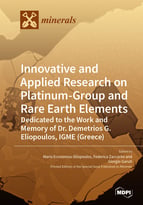Innovative and Applied Research on Platinum-Group and Rare Earth Elements: Dedicated to the Work and Memory of Dr. Demetrios G. Eliopoulos, IGME (Greece)
A special issue of Minerals (ISSN 2075-163X). This special issue belongs to the section "Mineral Deposits".
Deadline for manuscript submissions: closed (20 January 2020) | Viewed by 44894
Special Issue Editors
Interests: geochemistry of ore deposits and ore-forming processes; mineralization of platinum-group elements (PGE); bio-mineralization; contamination of soil and water by heavy metals and metalloids; contamination of groundwater by Cr(VI)
Special Issues, Collections and Topics in MDPI journals
Interests: mineralogy; electron microprobe analyses; ultramafic rocks; ore minerals; geochemistry; ophiolite
Special Issues, Collections and Topics in MDPI journals
Interests: ore deposits; geochemistry and mineralogy of noble metals; mafic–ultramafic rocks; ophiolite
Special Issues, Collections and Topics in MDPI journals
Special Issue Information
Dear Colleagues,
We are pleased to announce a Special Issue, "Innovative and Applied Research on Platinum-Group and Rare Earth Elements", as a contribution to the better understanding of their origin and genesis. This issue focuses on the role of magmatic-hydrothermal and epigenetic processes on the distribution of noble metals, i.e., platinum-group elements (PGE) plus Au and Ag, rare earth elements (REEs), and other critical elements in different types of ore deposit. The delineation of potential relationships between mineral composition and controlling factors during the long-term evolution of their geotectonic environment will be also considered. Due to the high economic importance, the increasing technological advances, and the increasing demand, the critical elements have attracted particular attention as regards their origin, availability, and sustainability. In addition, specific elements, such as palladium and platinum, were recently identified as a potential resource in porphyry–Cu systems; however, the extent of precious metal exploitation from that type of deposit remains unclear. Innovative research and review studies may provide new data on the geochemistry and mineralogy of critical metals, identify the genesis of ore deposits, and be used as exploration tools.
Prof. Dr. Maria Economou-Eliopoulos
Dr. Federica Zaccarini
Prof. Dr. Giorgio Garuti
Guest Editors
Manuscript Submission Information
Manuscripts should be submitted online at www.mdpi.com by registering and logging in to this website. Once you are registered, click here to go to the submission form. Manuscripts can be submitted until the deadline. All submissions that pass pre-check are peer-reviewed. Accepted papers will be published continuously in the journal (as soon as accepted) and will be listed together on the special issue website. Research articles, review articles as well as short communications are invited. For planned papers, a title and short abstract (about 100 words) can be sent to the Editorial Office for announcement on this website.
Submitted manuscripts should not have been published previously, nor be under consideration for publication elsewhere (except conference proceedings papers). All manuscripts are thoroughly refereed through a single-blind peer-review process. A guide for authors and other relevant information for submission of manuscripts is available on the Instructions for Authors page. Minerals is an international peer-reviewed open access monthly journal published by MDPI.
Please visit the Instructions for Authors page before submitting a manuscript. The Article Processing Charge (APC) for publication in this open access journal is 2400 CHF (Swiss Francs). Submitted papers should be well formatted and use good English. Authors may use MDPI's English editing service prior to publication or during author revisions.
Keywords
- Rare earth elements
- Platinum-group elements
- Chromite
- Magnetite
- Sulfides
- Laterites
- Ophiolites
- Calc-alkaline systems








